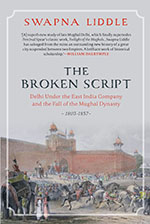A study of the ‘hybrid half-century’, The Broken Script is a narrative of the city of Delhi for the period 1803-1857, when the Mughal Empire witnessed the last vestiges of its power and the British East India Company emerged as the de facto ruler, marking the end of one way of life and the rise of another. It is the story of a city, ‘a fast-modernizing society’ in the midst of profound changes, a discussion on its culture, literature, language, intellectualism, its tehzeeb, social and economic life. It is also a narrative of the disruption, destruction and effacement of the city, more so, as an aftermath of the Revolt of 1857 that compels one into comparisons with the city of Delhi of the current times facing a grind under the pretence of urban renewal, revival and reconstruction.
Invoking the decline of the Mughal Empire, the book discusses the titular, symbolic authority of the Mughal emperors, treated as ‘puppets’ by courtiers and regional chieftains, themselves engaged in a scramble for power. Nevertheless, in popular imagination, the Mughal emperor was still seen as the rightful, legitimate sovereign and his charisma persisted.

